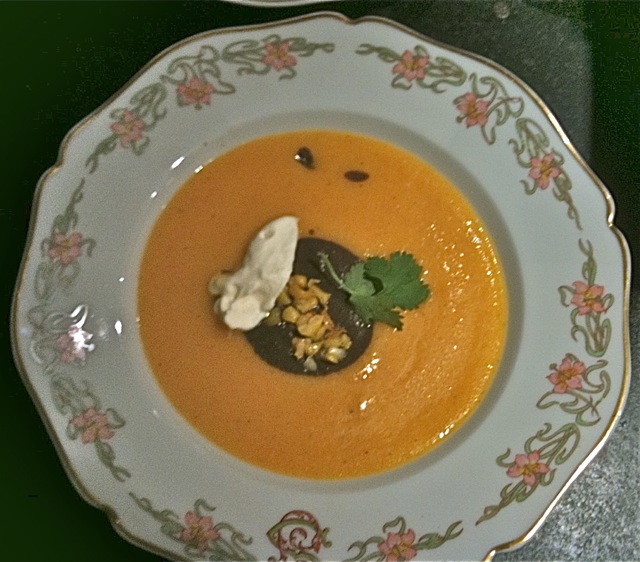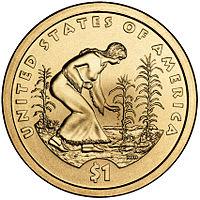I am back from a wonderful trip to the Pyrenees and a short visit to Paris. I arrived just in time to dive into the kitchen to prepare our Thanksgiving dinner. Husband, older son & daughter in law had been very efficient on getting all the necessary ingredients. They also took charge of brining & smoking our 14 lbs organic turkey — it turned out delicious. Joseph —the older son— made the best oyster dressing he ever made for us; he has been improving the recipe we have used for a few years and I will pass it on one of these days. I will not get into all the details of our dinner as I have a few deadlines coming up, but the one thing I will share from our 2010 menu is our Three Sisters Soup. There are many ways of making this soup, and I have made it many times, but I do think this year’s version is the best so far.
First, a little light on the origin of the name. The soup is named after the Native American technique of growing maize, beans & squash together:
Three Sisters (agriculture)
From Wikipedia, the free encyclopediaThe Three Sisters are the three main agricultural crops of some Native American groups in North America: squash, maize, and climbing beans (typically tepary beans or common beans).
In one technique known as companion planting, the three crops are planted close together. Flat-topped mounds of soil are built for each cluster of crops. Each mound is about 30 cm (1 ft) high and 50 cm (20 in) wide, and several maize seeds are planted close together in the center of each mound. In parts of the Atlantic Northeast, rotten fish or eel are buried in the mound with the maize seeds, to act as additional fertilizer where the soil is poor.[1][2] When the maize is 15 cm (6 inches) tall, beans and squash are planted around the maize, alternating between beans and squash. Milpas are farms or gardens that employ companion planting on a larger scale.[3]
The three crops benefit from each other. The maize provides a structure for the beans to climb, eliminating the need for poles. The beans provide the nitrogen to the soil that the other plants utilize and the squash spreads along the ground, blocking the sunlight, which helps prevent weeds. The squash leaves act as a “living mulch“, creating a microclimate to retain moisture in the soil, and the prickly hairs of the vine deter pests. Maize lacks the amino acids lysine and tryptophan, which the body needs to make proteins and niacin, but beans contain both and therefore together they provide a balanced diet.
Native Americans throughout North America are known for growing variations of three sisters gardens. The Anasazi are known for adopting this garden design in a more xeric environment. The Tewa and other Southwest tribes often included a “fourth sister” known as “Rocky Mountain bee plant” (Cleome serrulata), which attracts bees to help pollinate the beans and squash.[4]
2009 Native American dollar reverse with Three Sisters on it
In the past I made three different soups and served them together. This year I decided to make only the back bean and the butternut squash soups and serve the corn as a garnish on top. This added a pleasant texture to the dish.
Black Bean Soup:
I had some cooked black beans in my freezer. I sauteed one diced onion, added one jalapeno, salt, and a dash of Melinda sauce (for the chipotle pepper taste), added the beans and water. Let it cook for one hour. Then I blended it with cooking liquid. The consistency should be a little thinner than a smoothie.
Butternut Squash Soup:
I peeled a butternut squash and cooked it in salted water. Meanwhile I prepared a bechamel sauce:
Béchamel sauce
5 tablespoons butter
4 tablespoons all-purpose flour
4 cups milk
Melt the butter over low heat in a heavy sauce pan. Add all the flour, move away from heat and stir briskly until smooth. Add the milk & put back on the stove, stir continually with a wire whisk to prevent any lumps —this is a basic sauce that you can use for many other recipes like macaroni and cheese, or any other gratins, lasagnas etc.
Once the squash is cooked, blend it in a food processor with enough cooking liquid to obtain a thick consistency. Return to a pan and add as much bechamel as you like. Season with salt & pepper.
Corn kernels:
In a pan melt 1 tablespoon of butter. Add 2 cups of corn kernels, salt & pepper. Glaze them until golden and a little crunchy.
Keep your soups and the corn warm — I do keep everything in a chef pan double boiler mode— prepare the other garnish: cilantro, whipped cream & finely chopped jalapenos for the people who can handle it.
Once you are ready to sit down to dinner set up your plates.
1- Pour the butternut squash soup first.
2- The bean soup in the middle of the squash soup
3- Add a dolop of whipped cream, cilantro, chopped jalapeno and voilà! & bon appetit!



Hello Nicole, just got the recipe for the three sisters soup, which Jose and I loved. Jose generally does not like any soup, but her raves about this one and the entire meal. Once again, thank you so much for having us.
Hi Nicole–It must have been nearly 20 years ago when we first celebrated thanksgiving with three sisters soup.
Be well. Hope to see you over the winter holidays.